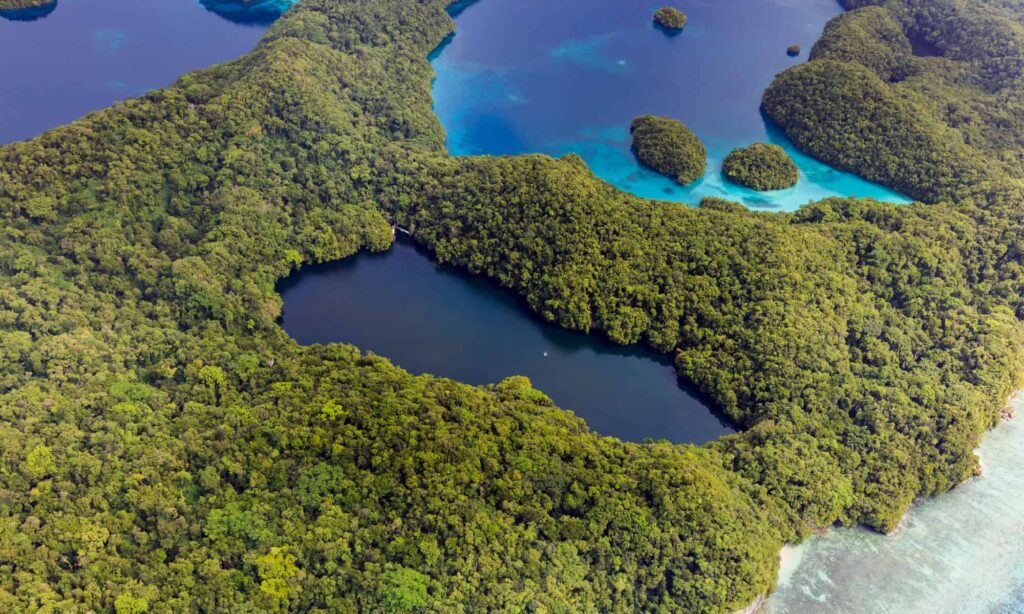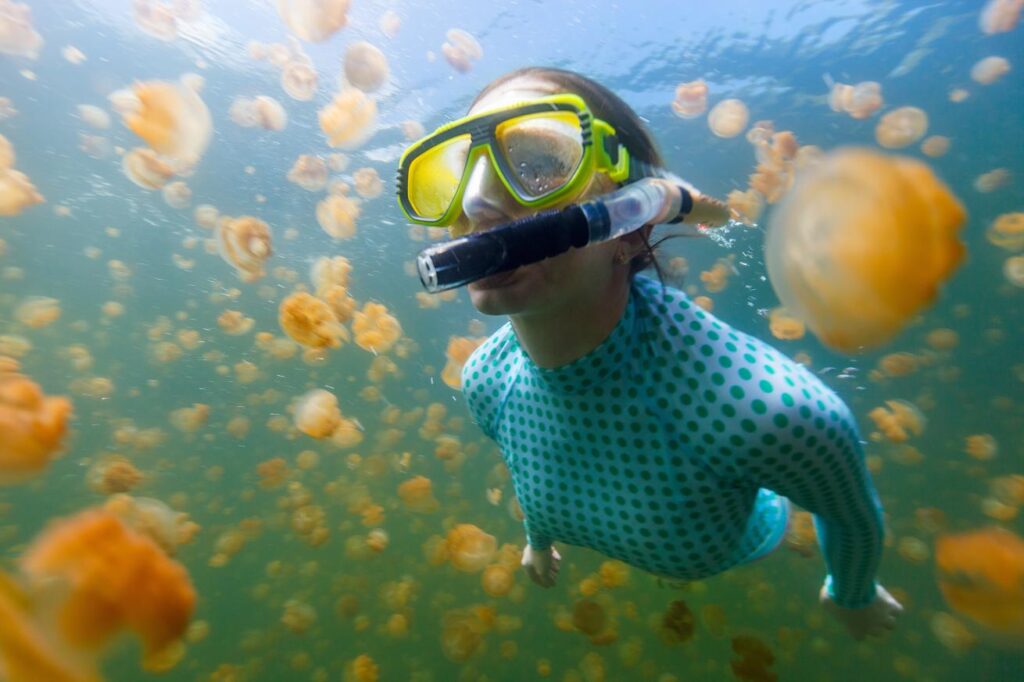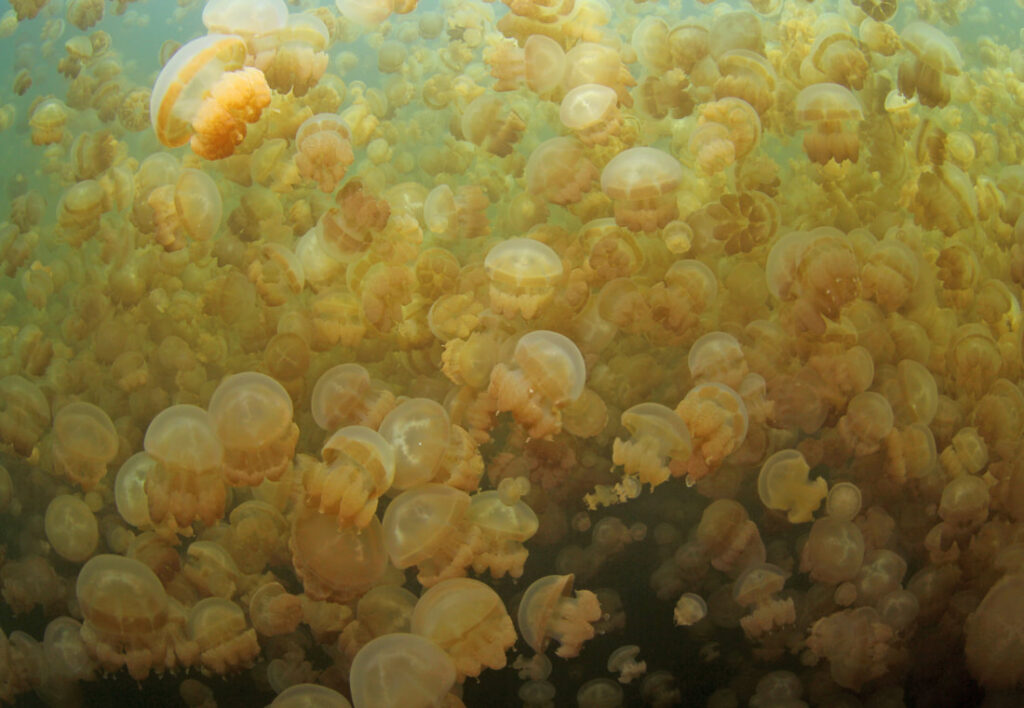In the heart of the Pacific, scattered among the emerald Rock Islands of Palau, lies one of the world’s most surreal natural wonders: Jellyfish Lake. Here, in an isolated marine lake surrounded by limestone cliffs and dense jungle, thousands—sometimes millions—of golden jellyfish drift silently through turquoise waters. And unlike their ocean cousins, these jellyfish don’t sting. They simply pulse gently around you, glowing softly in shafts of sunlight.
Snorkeling in Jellyfish Lake is less an adrenaline rush and more a dreamlike immersion into a living, breathing ecosystem—a quiet, otherworldly ballet in water.
The Hidden Lake of Eil Malk

Jellyfish Lake, known locally as Ongeim’l Tketau, is located on the uninhabited island of Eil Malk in Palau’s southern lagoon. It’s one of about 70 marine lakes in the Rock Islands, but the only one open to the public for snorkeling. The lake is accessible via a short but steep hike through dense forest, where you’re greeted by a wooden dock stretching out over still, greenish-blue water.
Despite being connected to the ocean through underground fissures in the limestone, the lake is isolated enough to have created its own unique ecosystem—one that has evolved in near-perfect harmony over thousands of years.
The Jellyfish: Evolution’s Gentle Marvel

The stars of the lake are the golden jellyfish (Mastigias papua etpisoni), a subspecies found only in this lake. Over millennia of isolation, these jellyfish lost their need for powerful stingers. With no predators to defend against, evolution took a gentler course.
These jellyfish have a symbiotic relationship with microscopic algae (zooxanthellae) that live inside their tissues. As the jellyfish slowly migrate across the lake each day, following the path of the sun, the algae photosynthesize and provide nutrients. It’s a beautiful, passive dance of survival and interdependence.
As a snorkeler, you can float quietly among thousands of these golden orbs, their soft, rhythmic pulses moving around you in every direction. It’s completely safe, utterly calming, and unlike anything else on Earth.
What It’s Like to Snorkel in Jellyfish Lake

After donning your snorkel and easing into the water from the dock, the first thing you notice is the silence. The lake is warm, still, and quiet. Then the jellyfish appear—first just a few, then hundreds, then seemingly thousands, surrounding you in every direction.
Because they are near-transparent and slow-moving, the sensation isn’t overwhelming. Instead, it’s serene. You float among these creatures as if in a slow-motion ballet, careful not to touch or disturb them more than necessary. The temptation to reach out is strong—but keeping your distance ensures the jellyfish (and the delicate ecosystem) remain unharmed.
Below about 15 meters, the lake contains a layer of hydrogen sulfide, which is deadly to humans and harmful to marine life. But snorkelers stay well above this zone in the top 5–10 meters, where the water is safe and the jellyfish congregate.
Conservation and Protection
Jellyfish Lake is a protected site within Palau’s Rock Islands Southern Lagoon UNESCO World Heritage area. The Palauan government closely manages access to ensure the lake is not damaged by overtourism.
To visit, travelers must obtain a Rock Islands permit, and only snorkeling is allowed—scuba diving is strictly prohibited to avoid disturbing the sensitive lower layers of the lake.
In 2016, a combination of climate change and El Niño conditions led to a dramatic drop in the jellyfish population. Fortunately, by 2019 the population had begun to recover, thanks to conservation efforts and natural resilience. Still, the event was a stark reminder of the fragility of such a unique ecosystem.
Tips for Visiting Jellyfish Lake

- Permits: You’ll need a Rock Islands + Jellyfish Lake permit (valid for 10 days) which can be arranged through your tour operator or hotel.
- Tour operators: Most trips to the lake are day tours from Koror and include stops at other snorkeling or kayaking spots in the Rock Islands.
- Do not wear sunscreen: Even reef-safe sunscreens are banned in the lake, as they can harm the jellyfish and algae. Wear a rash guard instead.
- Be respectful: Do not touch the jellyfish, and follow all instructions from guides to help protect the environment.
- Bring waterproof gear: Cameras, dry bags, and goggles are a must if you want to capture or remember the moment.
Final Reflections
Snorkeling in Jellyfish Lake is not just an unusual travel experience—it’s a humbling encounter with nature’s ability to surprise, adapt, and enchant. In a world full of harsh edges and hurried motion, the slow, silent grace of the jellyfish reminds us of the beauty in softness, the strength in fragility, and the wonder that still waits, hidden in the most unexpected corners of the Earth.
For those who seek something truly otherworldly—something gentle, glowing, and wordlessly profound—Jellyfish Lake is an invitation to float with nature’s poetry.
